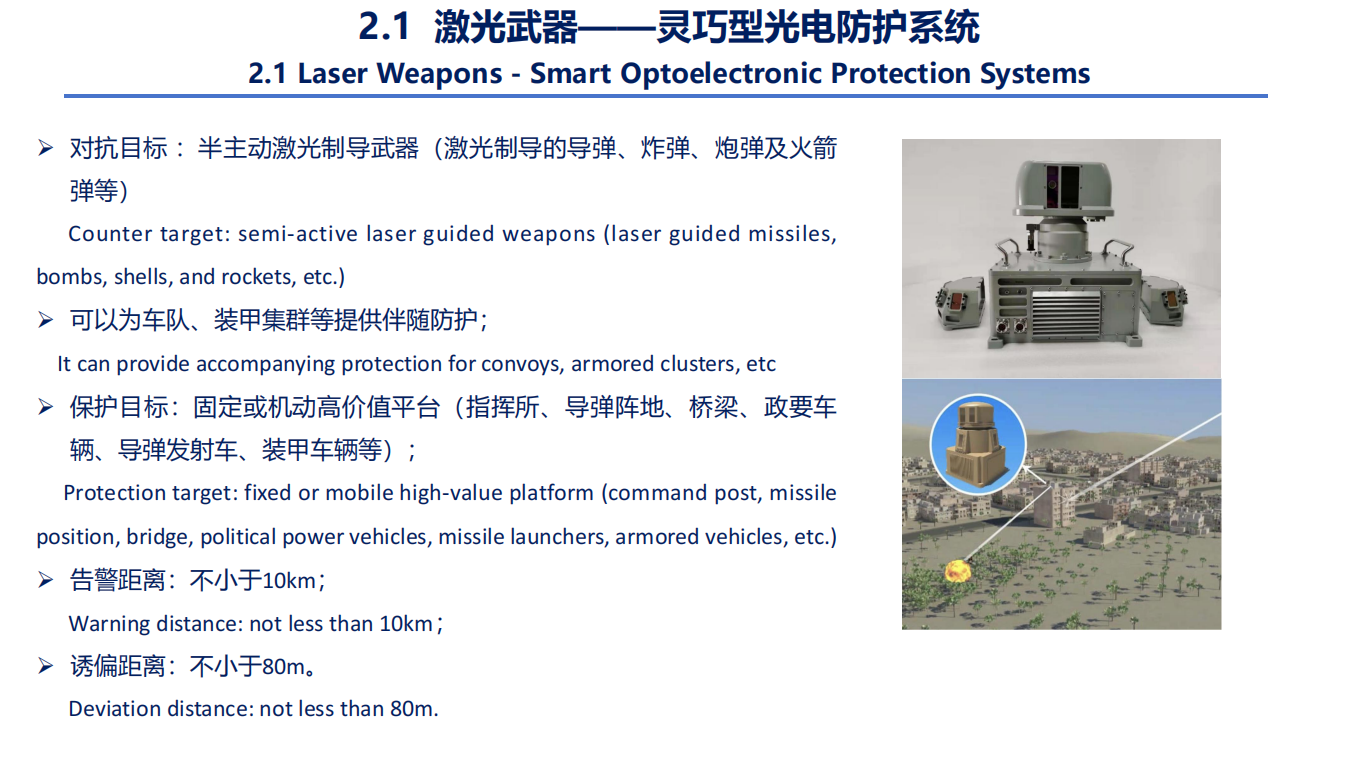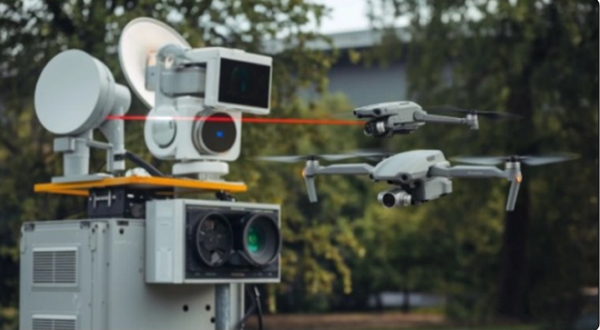Anti drone system refers to the technical system means used for detecting, tracking, and countering drones. These systems can include various technological means such as missile strikes, drone warning and monitoring, electronic interference, laser interception, etc., aimed at preventing drone intrusion and interference in specific areas or targets.
The anti drone system mainly consists of the following parts:
Monitoring and control module: responsible for monitoring and controlling the behavior of unmanned aerial vehicles.
Detection and tracking module: Capturing signals of unmanned aerial vehicles through radar and radio spectrum monitoring systems, and analyzing their position, speed, heading, and other information.
Disposal module: Based on the detected information, take corresponding measures such as launching missiles, conducting electronic interference, or using laser interception.
The application scenarios of anti drone systems are extensive, including military and defense, public safety, commercial activities, and many other fields. For example, in military applications, it is used to detect, interfere with, and destroy hostile drones to protect military facilities; Preventing security threats posed by drones in the field of public safety; Prevent drone intrusion into sensitive areas in commercial activities.
The rapid popularization of drones (also known as unmanned aerial vehicles) has changed the modern military and civilian fields. These versatile devices provide a range of applications from surveillance and reconnaissance to delivery and entertainment. However, the increasing use of drones has also raised concerns about privacy, security, and protection. As a result, a new technology has emerged: anti drone systems. This article will explore what anti drone systems are, how they work, and specifically study the functions of anti drone machine guns.
1、 What is an anti drone system
Anti drone systems are a set of technologies and strategies aimed at detecting, tracking, eliminating, or mitigating threats posed by hostile or unauthorized drones. These systems are used to protect sensitive areas, critical infrastructure, and major activities from potential drone threats. Anti drone systems can be divided into several categories, each utilizing different technologies to achieve their goals.
Types of anti drone systems:
(1) Detection system
Radar systems: These systems use radar to detect and track the movement of drones. Their working principle is to emit radio waves and reflect them onto objects, including drones. Then analyze the reflected waves to determine the presence, speed, and trajectory of the drone.
Radio frequency (RF) scanner: The RF scanner detects electromagnetic signals emitted by a drone while communicating with its controller. By analyzing these signals, the RF scanner can identify the presence and operating frequency of the drone.
Optical and infrared cameras: These systems use high-resolution cameras and thermal imaging technology to visually identify and track drones. Optical systems are particularly effective for detecting drones under clear conditions, while infrared cameras can detect thermal signals, making them very useful in low light or nighttime environments.
(2) Tracking system
Acoustic sensors: Acoustic sensors can detect the sound of drone propellers and engines. By analyzing sound features, these systems can locate and track drones. They are usually used in combination with other sensors to improve tracking accuracy.
Multi sensor fusion: This method integrates data from various sensors such as radar, RF scanners, and cameras to provide a comprehensive tracking solution. Multi sensor fusion improves tracking accuracy and reliability by combining different data sources.
(3) Countermeasure system
Electronic countermeasures: These systems can disrupt communication between drones and their operators, leading to drone loss of control. Electronic countermeasures include interference and deception techniques.
Physical interceptor: A physical interceptor is a device used to capture or destroy unmanned aerial vehicles. For example, mesh guns, projectiles, and laser systems.
Directed energy weapons: Directed energy weapons use concentrated energy such as lasers or microwaves to disable or destroy drones. These systems have high precision and can effectively strike drones in different ranges.
How does the anti unmanned machine gun operate
Anti drone machine gun is a special type of anti drone system designed to disable or incapacitate drones using directed energy or radio frequency signals. These guns are typically deployed in scenarios that require immediate action to eliminate drone threats. Anti unmanned machine guns are typically handheld or mounted on vehicles, and their design and functionality may vary depending on the intended use and technology.
Types of anti unmanned machine guns:
(1) RF gun
Radio frequency guns are designed to disrupt communication signals between drones and their operators. The working principle of these RF guns is to emit powerful RF signals at the frequency used by drones for control and communication. The main components of an RF gun include:
A Transmitter: The transmitter generates and amplifies radio frequency signals. These signals are transmitted to the target drone.
B Directional antenna: The directional antenna focuses the RF signal in a specific direction, improving the efficiency of the RF gun targeting the drone.
C Power supply: The power supply provides the necessary energy for generating and amplifying RF signals. It can be a battery or other power sources integrated into the gun.
Operation process: When the RF gun emits RF signals, it will interfere with the communication channel of the drone. This interference can cause the drone to lose control, resulting in the drone returning to its origin (if equipped with GPS function), landing safely, or crashing. RF guns can also interfere with GPS signals used by drones for navigation, further enhancing their effectiveness.
(2) Directional energy gun
Directional energy cannons use concentrated energy such as lasers or microwaves to disable or destroy drones. The working principle of these guns is to aim at the key components of the drone and apply concentrated energy to them.
A Laser gun: The high-intensity laser beam emitted by the laser gun can heat and damage the structure, electronic components, or propulsion system of the drone. The main components of a laser gun include:
·Laser emitter: The laser emitter generates and focuses a laser beam.
·Beam control system: The beam control system adjusts the direction and focus of the laser beam to accurately aim at the drone.
·Cooling system: The cooling system can prevent the laser components from overheating during operation.
Operation process: When starting the laser gun, the laser beam will be directed towards the drone, heating up and damaging its key components. This kind of damage can lead to drone malfunction or crash.
B Microwave gun: The microwave gun emits high-frequency microwave radiation, which can interfere with or damage the electronic system of the drone. The main components of a microwave gun include:
·Microwave transmitter: A microwave transmitter generates and guides microwave radiation.
·Waveguides: Waveguides and focuses microwave radiation onto the target.
·Power supply: The power supply provides the energy required to generate microwave radiation.
Operation process: When firing a microwave gun, microwave radiation can interfere with the electronic system of the drone, causing malfunctions or rendering its communication and control systems ineffective. This may cause the drone to lose control, crash, or land.
Advantages and limitations of anti unmanned machine guns
(1) The main advantages of anti unmanned machine guns
Precise destruction: Anti drone machine guns can accurately target specific drones and render them ineffective. Radio frequency guns can be used to disrupt communication signals while minimizing collateral damage, while directional energy guns can accurately target and destroy drones.
Instant Response: Anti drone machine guns are designed for rapid deployment and immediate response to drone threats. This makes them suitable for scenarios that require quick action to eliminate drone threats.
Multifunctionality: Anti unmanned machine guns can be applied to various combat environments and scenarios. For example, RF guns can be used in urban and rural environments, while directional energy guns can be effectively used in open areas with clear visibility.
(2) Limitations of Anti Unmanned Machine Gun
Range limitation: The effectiveness of anti unmanned machine guns is typically limited by their range. The effective range of RF guns and directional energy guns may be limited, requiring operators to maintain a certain distance from the target drone.
Weather and environmental factors: Environmental conditions such as rain, fog, or dust can affect the performance of anti unmanned machine guns. For example, weather conditions can reduce the effectiveness of laser guns or RF signals.
Legal and ethical considerations: The use of anti unmanned machine guns, especially directed energy weapons, may raise legal and ethical issues. Deploying such systems must comply with relevant regulations and ensure that there is no risk to personnel or property.
4、 Summary
Anti drone systems have become an important component of modern security and defense strategies. With the continuous development and proliferation of drones, the demand for effective countermeasures is increasing day by day. As part of these systems, anti drone machine guns provide targeted solutions that utilize radio frequency interference or directional capabilities to eliminate drone threats. Understanding the working principles, advantages, and limitations of these technologies is crucial for effectively integrating them into security and defense operations.
With the advancement of technology, anti drone systems and firearms may continue to develop, providing more complex and effective solutions to the challenges posed by unauthorized or hostile drones. In the dynamic and increasingly complex world of drone technology, being aware of these countermeasures at all times is key to ensuring safety, security, and operational effectiveness.




